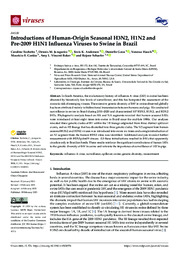Introductions of human-origin Seasonal H3N2, H1N2 and pre-2009 H1N1 Influenza Viruses to swine in Brazil.
Introductions of human-origin Seasonal H3N2, H1N2 and pre-2009 H1N1 Influenza Viruses to swine in Brazil.
Autoria: TOCHETTO, C.; JUNQUEIRA, D. M.; ANDERSON, T. K.; GAVA, D.; HAACH, V.; CANTAO, M. E.; BAKER, A. L. V.; SCHAEFER, R.
Resumo: Abstract: In South America, the evolutionary history of influenza A virus (IAV) in swine has been obscured by historically low levels of surveillance, and this has hampered the assessment of the zoonotic risk of emerging viruses. The extensive genetic diversity of IAV in swine observed globally has been attributed mainly to bidirectional transmission between humans and pigs. We conducted surveillance in swine in Brazil during 2011?2020 and characterized 107 H1N1, H1N2, and H3N2 IAVs. Phylogenetic analysis based on HA and NA segments revealed that human seasonal IAVs were introduced at least eight times into swine in Brazil since the mid-late 1980s. Our analyses revealed three genetic clades of H1 within the 1B lineage originated from three distinct spillover events, and an H3 lineage that has diversified into three genetic clades. The N2 segment from human seasonal H1N2 and H3N2 viruses was introduced into swine six times and a single introduction of an N1 segment from the human H1N1 virus was identified. Additional analysis revealed further reassortment with H1N1pdm09 viruses. All these introductions resulted in IAVs that apparently circulate only in Brazilian herds. These results reinforce the significant contributions of human IAVs to the genetic diversity of IAV in swine and reiterate the importance of surveillance of IAV in pigs.
Ano de publicação: 2023
Tipo de publicação: Artigo de periódico
Unidade: Embrapa Suínos e Aves
Palavras-chave: Disease surveillance, Genetic diversity, Genética Animal, Influenza A virus, Reassortment, Spillover, Suíno, Swine, Variação Genética
Observações
1 - Por padrão são exibidas publicações dos últimos 20 anos. Para encontrar publicações mais antigas, configure o filtro ano de publicação, colocando o ano a partir do qual você deseja encontrar publicações. O filtro está na coluna da esquerda na busca acima.
2 - Para ler algumas publicações da Embrapa (apenas as que estão em formato ePub), é necessário ter, no celular ou computador, um desses softwares gratuitos. Sistemas Android: Google Play Livros; IOS: iBooks; Windows e Linux: software Calibre.
Acesse outras publicações
Acesse a Base de Dados da Pesquisa Agropecuária (BDPA) para consultar o acervo completo das bibliotecas da Embrapa.

